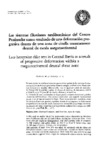Los sistemas filonianos tardihercínicos del Centro Peninsular como resultado de una deformación progresiva dentro de una zona de cizalla transcurrente dextral de escala megacontinental

View/
Use this link to cite
http://hdl.handle.net/2183/6085Collections
Metadata
Show full item recordTitle
Los sistemas filonianos tardihercínicos del Centro Peninsular como resultado de una deformación progresiva dentro de una zona de cizalla transcurrente dextral de escala megacontinentalAlternative Title(s)
Late hercynian dike sets in Central Iberia as a result of progressive deformation within a megacontinental dextral shear zoneDate
1991Citation
Cadernos do Laboratorio Xeolóxico de Laxe, 1991, 16: 169-177 ISSN: 0213-4497
Abstract
[Resumen] En este trabajo se analiza el contexto geotectónico global de los sistemas filonianos
intruidos en el centro peninsular durante tiempos tardihercínicos. Estos sistemas forman tres familias diferenciadas, con el siguiente orden de intrusión: 1) Diques EW de pórfido y aplita; 2) Filones de baritina, de direcciones N65 °E a N120oE; y 3) Diques NS de cuarzo, diabasa y lamprófido. La intrusión de estas tres familias de diques puede asociarse con los tres episodios
tectónicos tardihercínicos: Uno primer extensional, uno segundo transcurrente dúctil, y un último transcurrente frágil. Tanto estos episodios tectónicos, como los sistemas filonianos, pueden explicarse dentro de un esquema de deformación progresiva en una zona de cizalla transcurrente dextral de escala megacontinental (paniendo del clásico esquema para la provincia tardihercínica europea de ARTHAUD, F. YMATIE, Ph., 1977). [Abstract] In this work we analize the global geotectonic context characterizing the intrusion
of different dike sets in central Iberia during late Hercynian times. Three main dike sets might be distinguished, with the following order of intrusion: 1) EW porphyry and aplitic dikes; 2) N65°E to N1200E barite veins; and, 3) NS dikes of quartz, diabase, and lamprophyre. The intrusion of these three dike sets might be associated with the three late Hercynian tectonic events: A first one extensional, a second one ductile-transcurrent, and a last one brittle-transcurrent. Both these dike sets, and the tectonic events which triggered them, might be understand within a scheme involving progressive deformation within a megaconúnental dextral shear zone (fol1owing theclassical scenario for the late Hercynian european province of ARTHAUD, F. and MArrE, Ph., 1977).
Keywords
Sistemas filonianos
Tardi-Hercínico
Zona de cizalla
Dike sets
Late-Hercynian
Shear zones
Tardi-Hercínico
Zona de cizalla
Dike sets
Late-Hercynian
Shear zones
ISSN
0213-4497





